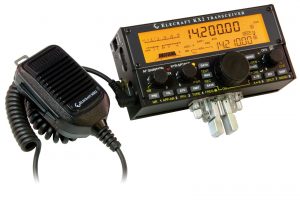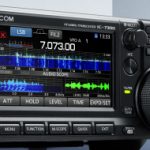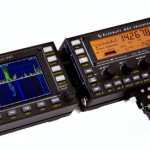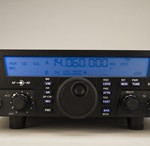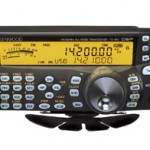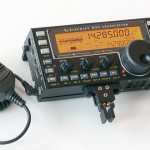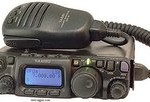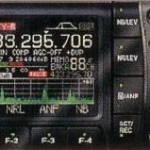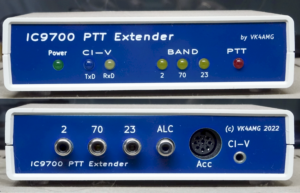Yaesu FT710 Has the innards of the latest FTDX101 series of radio’s. HF/50MHz band 100W Compact SDR Transceiver, SDR circuit configuration emphasizes Receiving Performance which is enabled by the same high-resolution A/D converter and FPGA used in YAESU high-end SDR transceivers. With many other features listed here: Also offers a lower cost price compared with others in this technology range worth a look.
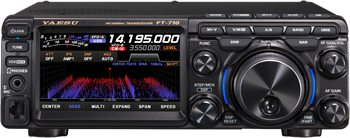
Icom IC905 144MHz-10GHz Yes thats right 2.4/5.8/10GHz. Very bold move by Icom to even list such a concept, let alone produce it. With band width decreasing all round the world for the mighty $, it’s refreshing to see one manufacturer striving to keep Amateur Radio alive. With the introduction of Software-defined radio (SDR) a radio communication system where components that have been traditionally implemented in analog hardware are introducing an easy way for the licenced amateur to widen their field of operation. Icom has ceased the opportunity to assist us all to transition to these normally expensive and experimental bands with this innovative concept, allowing the easy of operation alimenting expensive coax and pre amplifiers.
Specifications:
- The industry first VHF/UHF/SHF all mode transceiver with 144/430/1200/2400/5600 MHz and 10 GHz* coverage.
- Output power of 10 W for 144-1200 MHz, 2 W for 2400 and 5600 MHz, as well as 0,5 W for 10 GHz*.
- Color LCD touch display, waterfall and intuitive menu modelled after the IC-705.
- Power over Ethernet (PoE) technology improves the RF-module installation
- ATV (Amateur TV)
*10 GHz possible with the optional CX-10G transverter
Of course the price is yet to be disclosed, we all hope for a reasonable cost to assist us transition. See here for more
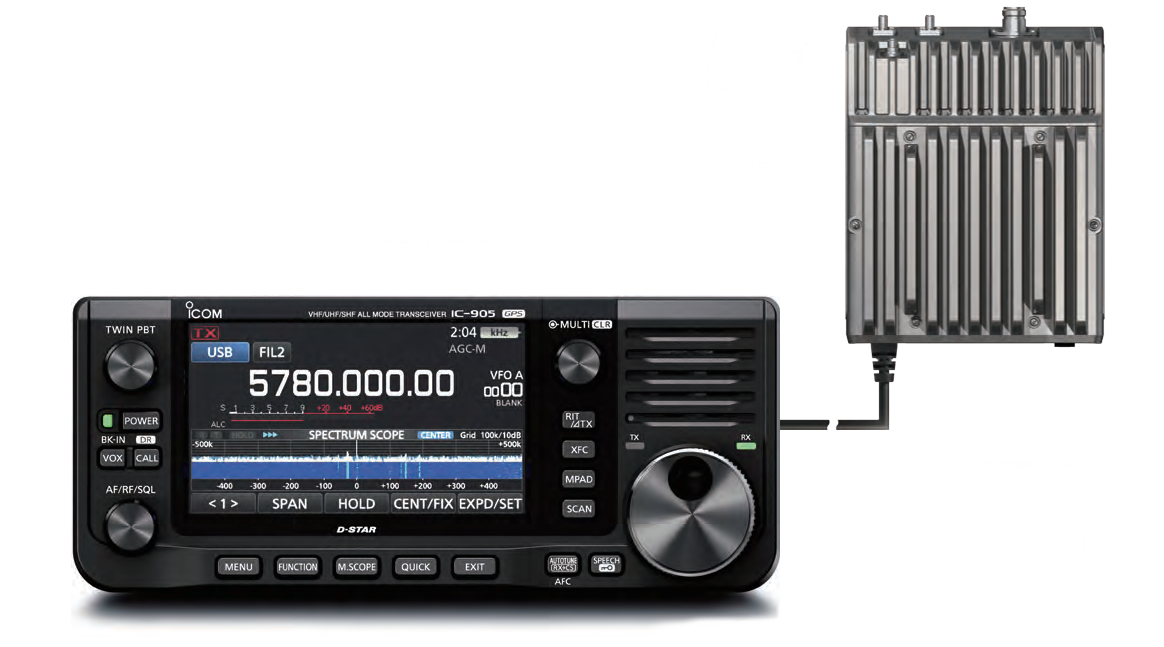
Please find more information in the brochure or in the promotion video.
Elecraft K4 HF- 50MHz (144 and 432MHz in the near future). Although not on the market as yet this radio boost the complete package. Like many things with the world in a pandemic, this radio has been delayed. Not all bad I guess as the principles of the company have suggest there design team has been working on upgrades and technical changes made to the first K4 to be released very soon(Late August 2020). Pricing not available (maybe A$4000-$8000). Read here for more
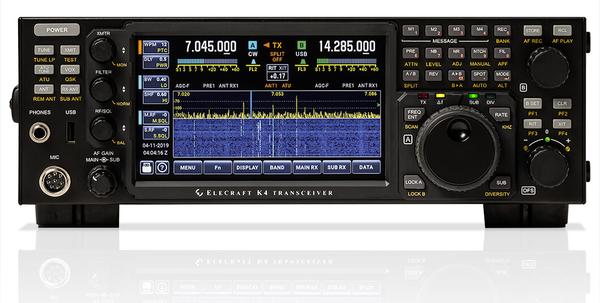
FT10DX. is Yaesu’s new Hybrid SDR Configuration
Like the FTDX101 series, the new FTDX10 utilizes the Yaesu Hybrid SDR configuration – Narrow Band SDR and Direct Sampling SDR. The Narrow band SDR receiver emphasizes excellent receiver performance, while the Direct Sampling SDR provides a Digital Processing Real-Time Spectrum Scope. Pricing around $2300.00
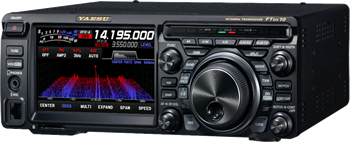
FTDX101D is utilizing the latest SDR Technology and classified as our High-End HF line, in the FTDX series. A Few Of The Remarkable Features Of The New FTDX101D Are: YAESU High-Class HF/ 50MHz 100W Transceiver SDR Technology and 3D Waterfall Display Large Touch Panel precision color display, Active Band Monitor, Independent control of the Main and Sub Bands allows effortless operation for the serious contester. Functionality Includes Digital Processing Generated Real-Time Spectrum Scope. *300Hz and 1.2kHz roofing filters (Optional) PC control software performed remote operation of the transceiver from a remote location via the LAN or the Internet is available. Some reviews although mixed results, some have been critical of its performance, suggesting to many bells and whistles etc. One thing is known to date, this radio leads the Sherwood Engineering receiver test. Pricing around $5-$6000 Check here for more
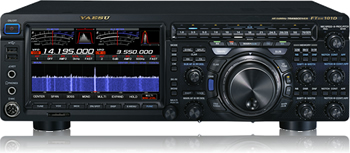
IC705 Coming soon (a field day dream). Mid August 2020 is the expected release date for this new Icom SDR/low powered HF – 432 MHz radio in direct competition to the trusted FT817 (only time will tell). Some of the latest mods are TX/RX CW, maidenhead display and a Roger beeping much more FSK/Dstar and the list goes on. Talking to Icom distributers this IC705 is more popular than the IC9700, released about a year ago. Pricing is just under $2000. For more on this product.
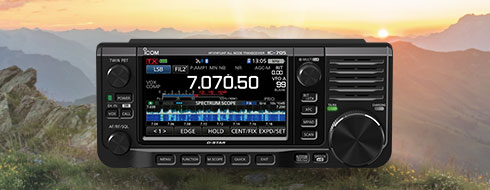
Direct Sampling Brought to the VHF/UHF World
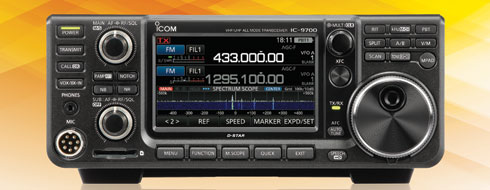
Built with the VHF/UHF weak signal operator in mind, the IC-9700 is an RF direct sampling receiver for 2m and 70cm. The IF receiver consists of a single, down conversion for 23cm that is between 311 – 371MHz. This design provides a quiet receiver due to Icom’s DSP technology. The robust PA provides 100W on 2m, 75W on 70cm, and 10W on 23cm.
Band Management
In addition to band specific memory channels, the IC-9700 allows band specific receiver and transmitter settings. For transmit, users can make adjustments to RF power, TX power Limit, Limit Power, and TX Delay by band. Basic receiver settings, like the Noise Blanker, Noise Reduction, and others can be tweaked by band with a dynamic Notch and Filter setup by band/mode.
Other Planned Features Include:
- All mode, tri-band transceiver covering 144, 430/440 as well as 1200MHz
- Supports CW/AM/SSB/SM/RTTY and D-STAR DV and DD modes
- Digital Data (DD) mode provides 128 kbps data communication
- PA provides a powerful 100W (144 MHz), 75W (430/440 MHz) and 10W (1200 MHz) output
- 4.3″ touch screen color TFT LCD
- Smooth satellite operation with normal/reverse tracking and 99 satellite channels
- Real-time, high-speed spectrum scope & waterfall display
- Dualwatch operation and full-duplex operation in the satellite mode
- Supports 2 wave simultaneous reception (different band / different mode), full duplex operation.
- D-STAR Terminal and Access Point mode (RS-MS3A/W)
- Dual D-STAR receive (decodes two voice streams simultaneously)
- Full duplex operation/Dual Watch (no V/V or U/U Capability)
- Main or Sub-Band Scope (Center/Fix mode +/-500kHz Center Mode)
- Audio Scope
- CW full break-n
- 0.5ppm frequency < +/- 0.5ppm (–10°C to +60°C; 14°F to 140°F)
- Voice Recording/playback function (SD Memory Card)
- Ethernet Port (Internal RS-BA1 Server)
- USB audio and control connection
- DR Memories: 2,500
Elecraft KX2 SDR
An 80-10 m SSB/CW/Data station that fits in your pocket!
Our KX2 “stealth” transceiver can go wherever your imagination takes you. Thanks to state-of-the-art construction techniques, it’s only 5.8 x 2.8 x 1.5” and weighs just 13 ounces—making it the smallest full-fea- tured HF radio on the planet. Yet it puts out up to 10 watts, covers 9 bands, and shares many features with the KX3. It also works with the KXPA100 amplifier.
To maximize your freedom to roam, you can outfit your KX2 with an internal 2.6 amp-hour Li-ion battery. Current drain is as little as 135 mA, yielding up to 8 hours of typical operation on a single battery charge. There’s also an internal automatic antenna tuner module (KXAT2), which can tune a random wire, dipole, or whip on multiple bands.
A rear tilt-foot angles the KX2 for use on any surface, from desktop
to park bench to rock. The KX2 also makes a great moble rig, and can
even be used hand-held. It includes a built-in mic for HT-style opera-
tion. the size of an HT!
KX2 Quick Specs
- Only 13 oz. (0.3 kg) – ideal for portable and hand-held operation
- Internal 2.6 Ah, 11 V Li-ion battery option
- Internal wide-range ATU option
- Current drain as low as 135 mA
- Built-in microphone and speaker
- Advanced DSP provides dual watch, noise reduction, noiseblanking, autonotch, stereo audio
- Versatile software-defined radio (SDR) architecture
- Operates in data modes (PSK31/RTTY) with or without a PC
- New KXPD2 compact keyer paddle
Finally…
a full-featured, 10-W, 9-band radio
The KX2’s powerful 32-bit DSP offers features dual watch, stereo audio, user-programmable filter bandwidths, noise blanking, noise reduction, and auto-notch. RTTY and PSK data modes are built in—no PC needed—as well as a memory keyer and digital voice recorder for transmit.
There are two padded carrying cases for the KX2, including the CS40 and larger CS60. Both include belt straps and an interior compartment.
Legendary Customer Support
Elecraft is committed to customer satisfaction (just ask our customers)! We offer full phone and email support, on-line manuals and applica- tion notes, and an active user forum.
(whip antenna not included)
Perfect for first-time HF operators; includes tutorial-style manual
KX2 Transceiver Specifications STANDARD FEATURES
- 80-10 meter ham bands; general coverage receive from 3-32.0MHz (also covers 0.5 to 3 MHz with reduced sensitivity)
- All modes: SSB, CW, and Data (four sub-modes)
- Ultra-compact size: 2.8”H x 5.8”W x 1.5”D; 13 oz (less options); low-profileknobs and feet for minimum height
- Rear tilt foot provides 3-point mount for rugged terrain
- Custom high-contrast LCD with alphanumeric text displayRECEIVER
- Software-defined-radio (SDR) architecture for versatility
- Switchable preamp and attenuator
- 8-band RX EQ
- Simultaneous dual receive over up to +/- 23 kHz for split-DX operation
- Built-in speaker; stereo jack for headphones or powered speakersTRANSMITTER
- Upto10Won80-15m,8Won12and10m(typ.)
- 100 W with KXPA100 amplifier
- Rugged, SWR- and temperature-protected final amplifier stage
- Use with built-in mic or MH3 (with UP/DN VFO functions)
- Optional KXPD2 keyer paddle with adjustable contact spacing; easilyremovable for transport; built-in allen wrench storage
OTHER FEATURES
- General-purpose and per-band memories store VFOs, modes, etc.
- Computer control via supplied USB or RS232 cable
- Free firmware updates via provided application software
- Programmable switch (PFn) for access to an often-used menu entryOPTIONS AND ACCESSORIES
KXAT2 Internal, Wide-Range Automatic Antenna Tuner
KXBT2 Lithium-ion Battery Pack; 11 V, 2.6 Ah. Can be plugged ininternally or externally.
KXBC2 External Lithium-ion Fast-Charger for KXBT2 Battery Pack KXPD2 Attached Precision Keyer Paddle
CS40 & CS60 Compact Padded Carrying Cases. The CS40 is sized for the KX2, a wire antenna, earbuds, keyer paddle, log, and small accessories. The larger CS60 will accommodate an MH3 mic and more accessories.
CS40 CS60 KXPA100
• Current drain as low as 135 mA in receive mode
• High-performance 32-bit floating-point DSP
• Built-in PSK/TTY decode/encode allows data mode operation without a
PC; transmit in data modes using CW keyer paddle
• Synthesizer has 1-Hz tuning resolution
• Integrated numeric keypad for direct frequency entry
• Easy-to-use Passband Tuning (PBT) for shift/width/hicut/locut; roofing filters automatically track DSP filter settings
• Auto-notch removes interfering carriers; adjustable noise reduction and noise blanking; stereo audio effect
• Center-tuning indicator for CW and data modes; auto-spot
• CW keyer with 8-50 WPM range; fast, full-break-in keying
• Built-in digital voice recorder (DVR) with 2 message memories • Three CW/DATA message memories
• Fast, silent, PIN-diode T-R switching – no noisy relays
• DSP speech processing for excellent “punch”
• 8-band TX EQ tailors passband to your voice and microphone
• Full remote-control command set works with popular computer soft- ware applications
• Selectable switch-press tones or full Morse code-based interface • Tutorial-style manual ideal for new hams
MH3 Hand Microphone with UP/DN Controls
KXIO2 Real-Time Clock + General-Purpose Outputs. Clock time-keep-
ing accuracy can be fine-tuned. AUX 1 & 2 outputs are open-drain; for per-band control of relays to switch antenna coil taps, transverters, etc.
KXPA100 High-Performance 160-6 meter, 100-W Ampflier. See below; also works with other 5 to 10 W transceivers.
KXAT100 Wide-Range 100-W ATU with Dual Antenna Jacks. Mounts inside KXPA100 amplifier.
The Innovative HF Transceiver
New technology is changing the way receivers are being designed and the IC-7300 is an industry first as an RF, Direct Sampling System is being used in an entry level HF radio. The ability to digitize RF before various receiver stages reduces the inherent noise that is generated in the different IF stages of a radio. We feel the performance of the ‘7300 will far exceed your expectations for a radio considered entry level.
Output power:
100W (25W AM)
RX Frequencies:
0.030-74.800
Receiver type:
Direct sampling
RF direct sampling system
The IC-7300 employs an RF direct sampling system, where RF signals are directly convert to digital data. Then processed in the FPGA (Field-Programmable Gate Array), making it possible to simplify the circuit construction as well as reduce noise that can mask weak signals.
The new “IP+” improves the 3rd order intercept point (IP3) performance improving the ability to copy a weak signal that is adjacent to either a strong interfering signal. In this process, A/D converter is optimized to reduce or eliminate signal distortion.
RF Direct Sampling
RMDR and phase noise characteristics
The IC-7300’s RMDR is about 97dB* (typical value) improving the Phase Noise characteristics by about 15dB (at 1 kHz frequency separation). The superior Phase Noise characteristics reduce noise components for both receive and transmit signals.
* At 1 kHz frequency separation (received frequency: 14.2MHz, MODE: CW, IF BW: 500Hz)
RMDR aand phase noise characteristics
15 discrete band-pass filters
The RF Direct Sampling is protected by an array of bandpass filters. The signal passes through one of the fifteen bandpass filters, where signals outside the passband are rejected. To reduce the insertion loss, the IC-7300 utilizes High Q factor coils.
Large color touch screen
The large 4.3” color TFT touch LCD offers intuitive operation of functions, settings, and various operational visual aids such as the band scope, waterfall function, and audio scope. Like on the high-end rigs, the waterfall shows a change of signal strength over a period of time and allows you to find weak signals that may not be apparent on the spectrum scope. Use the audio scope function to observe various AF TX/RX characteristics such as microphone compressor level, filter width, notch filter width and keying waveform in the CW mode. Image below shows the Audio scope with the waterfall function and the oscilloscope. Touch screen display
Touch screen displayWaterfall function
Waterfall function Audio scope function
Audio scope function
Real-Time spectrum scope
You no longer have to choose whether to listen to the audio or have the spectrum scope sweep for signals as the IC-7300’s real-time spectrum scope offers the simultaneous operations found in some of the more expensive rigs! This means you can use either the spectrum scope or the waterfall to quickly move to an intended signal while listening to the receiver audio. The ‘7300’s touch screen introduces a “Magnify” function. So, when you first touch the scope screen around the intended signal, the touched part is magnified. A second touch of the scope screen changes the operating frequency and allows you to accurately tune.
Spectrum scope specifications
Scope system FFT (Fast Fourier Transform)
Sweep speed Max. 30 frames/second (approx.), selectable from slow, mid or fast
Span width 5kHz–1000kHz
Resolution 1 pixel minimum (approximately)
Waveform display area (vertical axis) 80dB
Reference level adjustment –20dB to +20dB
Peak level hold function (Max. hold) ON/OFF/last 10 seconds
Other functions Averaging indication
Touch screen operation
VBW (Video Band Width) adjustment
Additional Features:
Built-in automatic antenna tuner
101 channels (99 regular, 2 scan edges)
SD memory card slot for saving data
Cooling fan system
Multi-function meter
CW functions: full break-in, CW reverse, CW auto tuning
SSB, CW, RTTY, AM, FM modes
see more here: http://www.ab4oj.com/icom/ic7300/7300notes.pdf
Elecraft PX3 This must be a must have for the KX3 read more here: http://www.elecraft.com/manual/PX3_Manual_E740229_REVA.pdf
PX3 PANADAPTER
High-performance companion panadapter for the Elecraft KX3 transceiver
Full-color waterfall and spectrum displays, with fast sweep and excellent sensitivity
Simple plug-and-play operation—no PC, soundcard, software drivers or setup required
Weighs just 13 oz (0.37 kg); enclosure size: 5.4 x 3.4 x 1.7” (13.7 x 8.6 x 4.3 cm)
Portable, High-Performance Panadapter
Our new PX3 Panadapter adds a visual dimension to signal hunting, with fast, real-time spectrum and waterfall displays of band activity. Its small size and weight make it ideal for travel or field use.
The PX3 is fully integrated with the Elecraft KX3, utilizing its serial control port and RX I/Q signals*. The panadapter tracks the KX3’s VFO frequency and filter settings via on-screen cursors. You can point and click on signals by rotating and tapping the PX3’s SELECT knob.
With its very wide dynamic range and frequency span of up to 200 kHz, the PX3 offers better performance than most PC sound cards. It’s also one of the most sensitive panadapters available, detecting signals down to the noise floor of the KX3. A PC or Mac can still be connected to the KX3 (via the PX3) for use with logging and control programs.
Advanced Features and Signal Processing
PX3 features include multi-pass signal averaging to pull out weak signals, peak detection to show total activity on the band, adjustable reference level, and amplitude range scaling. There’s also a full set of programmable switches to access often-used settings.
The PX3 has a wide supply voltage range (8-15 V) and low current drain (typ. 140 mA @ 13.8 V). It includes a comprehensive manual, and is available factory assembled or as a modular, no-soldering kit.
Planned future features include:
CW/RTTY/PSK text display
Use of the built-in USB port with a keyboard or flash drive
SVGA monitor output option
* The PX3 uses the KX3’s baseband RX I/Q signals. It is not compatible with the 8.2-MHz I.F. signal from the K3.
As my Elecraft K3 is the most important and most expensive item in G4ILO’s shack, some readers may be surprised that there is no review of the K3 in the Reviews part of my main site. The reason is that when I first received my K3, I was quite disappointed with it in many respects. Many of the advertised features that were among my reasons for buying it were still to be implemented when the first radios were shipped. Any criticisms that I made at the time would, I hoped, eventually be obsolete. So I have been waiting for the K3 to be finished, or at least to perform as I expected, before giving my verdict.
More than two years on from its inital announcement, there are still things I’m waiting to be finished or put right. So I am publishing my review in this blog, representing my thoughts about the K3 at this point in time, rather than on my main site.
My reason for buying a K3 in the first place was largely just that it was an Elecraft. I had owned a K2 since 1999 and had built several of Elecraft’s other kits and modules since then. I have great admiration for Wayne, Eric and Lyle, talented radio designers who are not afraid to take an innovative approach in their products. They are also enthusiasts for their products, happy to engage with their customers through the medium of the Elecraft email reflector and respond to criticisms and suggestions. Elecraft has a first class reputation for customer service. None of what I am about to say is intended to detract from any of that.
However, the K3 exists in a marketplace alongside many other radios. It has to be judged by how well it compares with its competitors in its price class, and those below it. The K3 is lauded as the radio with the best receiver, able to pick out weak signals in close proximity to very strong ones better than anything else. It is claimed to be better even than more expensive radios. For many keen DXers and contesters that capability may be important enough to justify overlooking other failings. However, for the average Joe Ham with poor to moderate antennas in a QTH with a noise floor filled with emissions from electrical devices such receive characteristics have little value except perhaps to give bragging rights. It’s how a radio looks, feels and sounds, how comfortable it is to use, and how suitable it is to use for modes other than CW or SSB that many of us ordinary Joes like to play with, that are more important. And in many of those respects the K3 does worse even than some of the cheaper alternatives.
To start with the look and feel. In pictures, and at a normal operating distance, the K3 looks quite attractive, if stylistically somewhat dated. However, its compact size suggests a medium to budget price radio rather than high end. Close up, the many screw heads scream “kit built”, which of course my K3 actually is. The poor paint finish, plasticky knobs and gritty feel of the smaller rotary controls also say “cheap”, which the K3 certainly isn’t. Some of those complaints are a direct result of the K3’s design aims to be user assembled (if required) and light weight (for portable / DXpedition use.) But most K3s are bought ready assembled and never move from the shack desk, and those buyers may not accept the compromise. The K3 is a radio to use, not drool over.
A frequent criticism of the K3 is its poor ergonomics, especially the lack of separate band and mode buttons. It’s a fair point: other radios in the K3’s price class are bigger, and can afford larger controls and more buttons. Both my K2 and my FT-817 select band and mode by up/down buttons, so I felt that was something I could live with. Still, every time I change band instead of mode, or vice-versa, or go the long way round when making a change, it’s annoying. And it’s an annoyance that’s easier to forgive in a radio as tiny as the FT-817 that has no choice in the matter than in one that could easily have been made a bit bigger.
My biggest irritation with the K3 is its implementation of memories, which is frankly awful. In every other radio I have used, you press a button labelled V/M to switch between VFO and memory mode. In memory mode, you immediately go to the last selected memory band/frequency/mode etc. The VFO or some other control then acts as a rotary switch which you can use to change memory, and as you change memory the transceiver immediately changes to the band/frequency/mode/repeater shift etc. that has been programmed into that memory.
In the K3 there’s no such thing as memory mode. You’re always in VFO mode. You can save frequencies to memory and you can recall frequencies from memory back to the VFO but when you press M>V the first time, the radio stays where it is. You rotate the VFO and the memories change in the display, but the radio still stays where it is. You’re just selecting the memory you want. You have to press M>V again before it will actually change to the band/mode stored in the displayed memory. So you can’t use the memories to quickly check for activity on a list of different frequencies. This probably isn’t something SSB or CW operators want to do. But FM users will, for sure.
To try to overcome this criticism and provide the opportunity to scan a selection of memories Elecraft introduced what they call channel-hopping memories. This smacks of an ugly workaround that is only a small improvement over the standard behaviour. To make a memory a channel-hopping memory you must give up the first of the characters in the alphanumeric tag for each memory and make it an asterisk. The K3 will then scan a block of consecutive memories tagged with an asterisk almost as if you’re in memory mode, actually changing the frequency and listening there. You can even rotate the VFO to scan through them manually. But – and here’s the killer – it ONLY changes the frequency, not the mode, the repeater shift, the access tone or any other attribute stored in that memory. To fully load the memory into the radio, you still need to press V/M again.
The K3 has the best support of any radio, bar none, for using transverters. You can have up to 10 of them, and the K3 will display the actual VHF or UHF frequency when you are using one. Elecraft has even brought out an internal 10W 2m transverter option. So this is a radio that many people might choose over an IC-746PRO or TS-2000 to use not just on HF, but also to chat on their local 2m simplex and repeater channels. You’ll need to buy a crystal filter for FM, which will cost you as much as a budget 2m HT, but you’ll get a receiver whose adjacent channel rejection and signal to noise ratio on weak signals is second to none, and certainly better than the aforementioned Icom and Kenwood radios.
But the K3’s flawed implementation of memories makes FM operation a nightmare. You program your local repeaters and simplex channels into a block of channel-hopping memories. You then select a repeater and make a call through it, successfully. Then you turn the dial to cycle through the other memories and hear someone calling on a simplex channel. You call, but they won’t hear you because you didn’t remember to press M>V so you still have the repeater shift on from your previous contact. Or if you hear someone on another repeater and call him, you may have the wrong access tone. The K3’s memory implementation is completely unintuitive. Unless Elecraft completely redesigns it to work like other radios, go for the Icom or Kenwood if you plan on doing much FM operation.
The disaster that is the K3’s memory implementation suggests a radio that was designed by people with little experience of anything besides HF CW and SSB operation – or indeed experience of how the competition did things. Certain other aspects of the K3 tend to support that suggestion.
The K3 could have been the digital mode operator’s dream radio. There is built-in support for encoding and decoding both RTTY and PSK31, though you must send using a Morse paddle rather than a computer keyboard, and the K3’s display doesn’t provide much space to show the decoded text in a scrolling window. In the DATA mode, the K3 implements a “soft” ALC that lets you set a comfortable audio drive level and then keeps the power output constant across almost the entire range of the audio spectrum. Click the cursor on any signal in the waterfall and just call. No more constantly tweaking the PC mixer slider level to control the power level and keep the drive below ALC to maintain a clean signal. It’s PSK heaven!
Like most modern transceivers, the K3 offers both transmit and receive equalization: perfect for voice modes. For sound card digital operation, though, you want a flat audio response with no equalization. Other radios that have both a DATA mode and equalization turn the EQ off when the data mode is selected. Even radios that cost half the price of a K3 can do this. But not the K3. So if you’re a keen digimode operator and don’t want to have to manually change the EQ settings whenever you switch from phone to data, you’ll just have to leave the equalization flat. Elecraft knows this is an annoyance, but apparently it is difficult to change due to the way the firmware has been written. So we’re still waiting.
Which brings me back to the point that more than two years after its announcement, and more than 18 months after I first received it, I’m still waiting for some aspects of the K3 to work as expected. Believe it or not there are still advertised features such as synchronous AM detection that have yet to be implemented. I purchased the high stability TCXO option and there is a facility, described in the manual, for you to enter in temperature calibration data to increase its stability. Except it does not exist. It’s still to be implemented.
In a nutshell, my verdict on the K3 is: great hardware, shame about the firmware. Two years since its first announcement, it’s still a work in progress.
The IC-9100 is essentially the “plus” version of the IC-7410 reviewed in October 2011, and it shares many traits with that radio vis-à-vis its HF and 50 MHz capabilities, which we won’t reiterate here in detail.1 But it’s not quite that straightforward. With the IC-9100’s substantially higher price tag come the IC-7410’s HF and 6 meter performance plus all-mode VHF, UHF and satellite features and capabilities. Think of it as a shack in a box. Is the IC-9100 a good value and match for your operating style and preferences — not to mention your budget? We’ll report. You decide. Let’s take a look.
Genealogy
We’re tempted to think of the IC-7410 and IC-9100 solely as descendants of ICOM’s venerable IC-746/756 platform (with a bit of IC-706 DNA thrown in for good measure). But, the ’9100’s nomenclature also recalls ICOM’s noteworthy VHF-UHF three-band all-mode transceiver of a decade ago, the IC-910H. It comes as no surprise that the IC-9100 has retained the best features of its older sibling. ICOM and other manufacturers offer several all-mode transceivers that cover from HF through 440 MHz. The IC-9100, however, is only one of two currently avail- able desktop radios that include an option for 1.2 GHz.
Fish or Fowl?
ICOM has done a creditable job of balancing the IC-9100’s HF+50 MHz performance with
1R. Lindquist, N1RL, “ICOM IC-7410 HF and
6 Meter Transceiver,” Product Review, QST, Oct 2011, pp 49-54. This review and reviews of the other ICOM transceivers mentioned here are available to ARRL members online at www.arrl.org/product-review.
its expanded VHF and UHF coverage and capabilities. The bare-bones IC-9100 is a full-featured 100 W transceiver for HF,
6 meters, 2 meters and provides 75 W on
70 cm, with all the goodies you’d expect for FM simplex and repeater operation plus satellite work. With our IC-9100 we ordered the optional UX-9100 23 cm module (10 W), UT-121 D-DSTAR module, optional narrow 1st IF (“roofing”) filters for HF and 50 MHz and the RS-BA1 IP Remote Control Software package that permits remote control via the Internet or other IP network (more on this later). Add a power supply and antennas, and you’re ready to cover considerable Amateur Radio real estate in relative style — without even having to be in your shack!
Doubling and Tripling Down
Packing these expanded capabilities into a box that’s very similar to the IC-7410’s and that has a nearly identical front panel requires many dual-purpose (or multi-purpose) buttons and controls. The labels are the same, nicely contrasting white-on-black style as the ’7410’s and easy to read, once you’ve deci- phered the abbreviations dictated by space restrictions. Legends for some second and third-tier functions can be harder to make out. Good shack lighting helps considerably.
The ’9100’s broader and more-complex range of functions, especially those reserved
for satellite work, means a steeper learning curve. The IC-9100 diverges from the IC-7410 in several significant ways, starting with the front panel, where there’s been a bit of musical chairs between models. The ’9100 features two independent receivers and can receive on two bands at the same time — although not on two HF bands.
There’s a single MAIN DIAL for tuning, but the main and sub receivers do have separate (and concentric) AF GAIN and SQUELCH controls. With a stereo headset (or separate speakers) you can listen to both receivers at the same time, one in each ear. To do things such as operating split on HF means setting up VFO A and VFO B to the appropriate frequencies (you can designate a default split — say,
2 kHz — via the menu). The split function is independent from the repeater split function, also set via the menu.
The ’9100 includes a DV/DR button (for digital voice/digital repeater operation) among the
|
Bottom Line |
|
Compact and versatile, the IC-9100 handles almost any type of operating on the 160 meter through 2 meter bands, plus 70 and 23 cm. |
Ten Tec EagleThe new (2010) Ten Tec® Eagle® (model 599) isn’t what I personally would call a mobile transceiver, although it is, in part, advertized as one. At 2.9″ x 8.5″ x 10.25″, and about 8 pounds, it does qualify I suspect. It is not remotable. If nothing else is in evidence, it is the most expensive (usable as a mobile) transceiver ever! The MSRP is $1,995 for the model with an antenna tuner, and $1,795 for the one without. By the way, that is exactly what you pay as Ten Tec only sells direct to consumer! But, that’s not all. The mobile mounting bracket is $50, an optional 1.8 kHz SSB filter is $125, the noise blanker option (with just two selectable levels) is $49. It does come with a 2.4 kHz roofing filter, but there is room for three more at $125 each. That adds up to a very expensive mobile radio!
The display is monochrome, but you can change the background color (256 unique colors). It also has 16 levels of brightness, albeit difficult to change while driving down the highway at 70 mph. The specs aren’t all that bad. It has two DC output ports, but at just .5 amps maximum draw, don’t expect to power your screwdriver antenna with one.
One very curious feature; the fuse is located on the back panel of the radio, right next to the chassis-mounted Anderson Power Pole Connectors. On-line photos do not show fuses in the optional DC power cable ($49), a fact I would question. All is not bad, however.
While I personally am not a lover of all things Ten Tec®, they do have a very fine reputation of customer service, and support. On-line blogs support that scenario. If you’re in the market for a rather high-priced, miniaturized transceiver, I suspect the 599 might fit the bill for some folks.
Advisory CommentRegardless of TenTec®’s stance, I personally don’t believe the 599 is a viable mobile transceiver, if for no other reason than its lack of remote control capability. And, by the time you’ve purchased the optional hardware to bring it up to snuff with its competition, you’ve spent over $2,200! That is indeed heady territory.
Kenwood TS-480The only real mobile entry from Kenwood is the TS-480. It comes in two iterations; a 100 watt version with a built in auto coupler, and a 200 watt version without the coupler. The latter is a poor man’s amplifier, as no other made-for-mobile radio offers this much power. The street price for the Hx version is $1,100, and the Sx (SAT) $999.
The head, and the main body cannot be connected together (remote only). As with other Kenwood transceivers, the microphone plugs into the main unit, not the head. The cables (control and microphone) have pre-installed split beads to minimize RFI problems. This brings up another potential problem. The option cable extension kit might be needed in some installations. Rather than use CAT5 cables, buy the real deal. If you don’t, you’ll be plagued by RFI problems.
Calling it a miniature radio is a bit of a misnomer. It is approximately 7 x 2.5 x 10 inches, and weighs in at just over 8 pounds. Its 16 bit DSP is AF based, but Kenwood has done a decent job of designing out some of the problems that have plagued most AF based DSPs. There are optional SSB and CW filters available. The 1.8 kHz improves the already decent selectivity ratings compared to the other made-for-mobile offerings. However, if you’re forced to use the noise blanker, the selectivity advantage disappears.
Speaking of optional devices, here’s a good suggestion. Order the optional VGS-1 voice guide and storage unit. Like the Icom IC-7000, it reads out all of the vital settings in the radio, and it also allows recording up to 90 seconds (3 x 30 seconds) of audio. The audio can be used to record, and play back any transmission, as well as CQ and CW messages. It is well worth the $80 it sells for.
The funny looking serrated plate shown in the photo is the mobile mounting bracket for the head, which is attached with double-sided sticky tape (and optional self-tapping screws). For some, this could be a drawback. If you use this type of mounting, remember this: Some automotive surfaces can be damaged and/or stained by the tape. Wherever you mount it, make sure is well out of reach of any SRS device. That virtually rules out the top of the dash as shown in their advertising brochures. By the way, over their life time, vinyl plastics continually secrete volatile polymers, especially in hot weather. These polymers decrease the bond of most double-sided sticky tapes with predicable results.
The 200 watt (Hx) version requires two power hookups (or two separate factory power supplies if used as a base). These can be combined into one feed, but users should remember the radio draws about 40 amps, so heavy duty wiring is a necessity.
Both versions have two cooling fans, so full power, key-down operation is possible (30 minute limit, 25°C ambient). I’ve not heard folks complain about the noise they make when operating mobile, but to me they are a bit noisy. One thing to keep in mind, the main body of the radio requires good ventilation clearance on both ends which might negate some mounting locations, under seat for example. The Hx version also gets very warm, hot actually, in normal SSB operation, so don’t be alarmed if it does.
The manual has an interesting comment, which proves not everyone understands the origins, and cures for mobile egressed RFI. It states in part; If there is excessive noise, use suppressor spark plugs (with resisters as all new vehicles come equipped with), and/or DC line filters to reduce the electric noises. While the former suggestion might help, if you have to resort to using brute-force DC line filters, you haven’t installed your equipment correctly.
The TS-480 sports a CAT interface similar to those on the TS-2000, and there are quite a few after-market accessories which will work with this radio. Lastly, the two coax connectors are installed on dongles, rather than hard-mounted on the chassis. This fact could be a drawback for those who R&R the transceiver regularly.
Advisory CommentOne often expressed virtue of the TS480, is that it can be had in a SAT version, which sports an internal auto-coupler. Apparently, there is a misunderstanding about matching HF mobile antennas, that leads people to this conclusion. Like almost all built-in ones, the maximum matching range is up to a 3:1 SWR. In a mobile scenario, this will about double the the bandwidth of a monoband antenna, which in reality isn’t much of an improvement on 80 or 40 meters. Further, using one with a remotely-tuned antenna is problematic at best. The Hx version, at 200 watts PEP output, makes the need for a mobile amplifier all but moot. So my vote goes to the Hx version!
Elecraft KX3The Elecraft® KX3 is one of the latest miniaturized offerings. It is really designed as a portable, but I’m sure it will find a mobile following. It currently is available only in a 10 watt version, but an amplifier (KXPA100 amp) is coming in the near future. The KX3 has some unique features besides is very small size, and light weight (1.6 pounds). It has an advanced DSP replete with noise reduction, a dual watch feature (a great contesting tool), a noise blanker, an auto-notch, and stereo audio effects. The latter allows listening to both dual watch channels. It also has a roofing filter, all mode operation, and 160 through 6 meter coverage (a 2 meter module is coming). Pricing starts at $900 without accessories. If you need in-depth information, visit their KX3 web site.
Elecraft KXPA100
Just as intriguing, is the KXPA100 amplifier. Elecraft advertises it as a home/mobile amplifier which seamlessly integrates with the KX3 as well as other popular 5- to 10-W transceivers. An optional ATU with dual antenna jacks will also be offered. Pricing on the amplifier hasn’t been released (as of March 2012). Nonetheless, it will be interesting to see how the popularity of this transceiver progresses.
Advisory CommentThe KX3 is certainly a capable all-mode transceiver, and it’s dual watch-stereo features will surely make it a portable contesters dream. Obviously, these extra features increase the bottom line, and limit the mobile appeal. Installing a separate amplifier unit isn’t much different than installing a remotable transceiver like an Icom IC7000 which is a good thing. However, we’ll have to wait on pricing for the KXPA100 (≈$300 to $400, I’m guessing here), and to discover how seamlessly it integrates. This said, if Elecraft is up to their usual snuff, it will be an easy set up.
By now, you probably know that the FT-817 is a miracle in packaging. No one can believe how many bands and features have been stuffed into such a tiny box. We were amazed too.
But once we got over the gee whiz phase, we focussed on our usual issues. In our testing, we recognize that RF design is the art of making smart tradeoffs. For each radio we examine, we try to determine if the compromises made by the designer were the right ones, in light of the radio’s mission. No radio is perfect, but some designers manage the tradeoffs more successfully than others.
That is the standard to which we held the FT-817. Because most of our readers prefer the world of HF, we confined our testing to the HF bands.
Please remember that Yaesu will probably refine the FT-817 over time. Also, keep in mind that no Ft-817 will be exactly like any other, and our experience with the FT-817 will be different from yours. Finally, we occasionally make mistakes (which we promptly correct).
The Executive Summary
As the full report will show, the FT-817 is not a great performer. That might be appropriate if performance were being traded for some other worthwhile virtues.
One such virtue is low cost. In this realm, Yaesu may have made sensible tradeoffs. The radio’s performance is only ho hum, but many people may be willing to accept that level of performance in light of the FT-817’s low price. Of course, there are other cheap, modestly performing transceivers on the market, and we don’t know how the FT-817 would fare in a head to head comparison.
Another such virtue might be a tiny package. Is the radio’s minuscule size a virtue for which good performance has been rationally traded? In this case, we have our doubts.
Apparently, Yaesu believes that the FT-817’s small size qualifies it as “the utlimate backpacker.” (See the full page ad in the March, 2001 issue of QST.) But according to Yaesu’s own specs, this radio draws 450 mA on receive and 2.0 amps on transmit. This remarkably high current drain means that the FT-817’s internal batteries expire in a short time. It is necessary to lug around supplementary batteries to get reasonable use from this radio.
Would any real backpacker put up with such a current hog? We don’t think so.
Maybe microscopic size would be handy for business travelers, boaters, or other people who don’t have a lot of space, but can still handle the weight of extra batteries. However, there is a problem. Thanks to their relentless determination to shrink this radio, Yaesu’s designers hid a lot of important functions in menus. Furthermore, they used the tiniest knobs and switches on earth. If you are larger than Tinkerbell, this radio will irritate you.
For the handful of magnificent people who climb to the top of mountains and operate in VHF and UHF contests, the FT-817 might be the only existing radio that could meet their needs. For most other folks, once they have stopped admiring the cute little box, it’s hard to see how the FT-817 will deliver the goods.
The Crud Table
When you boil it down, most amateur radio transmitters do what they are supposed to. The problems lie with receivers. To be concrete, many receivers—ranging from appliances to kits—suffer from a severe case of crud.
They are ruined by insipid filters, phase noise, spurs, distortion from close-in strong signals (third order), distortion from widely spaced strong signals (2nd order), birdies, leakage on the image and IF frequencies, and nasty pops and thumps from AGC.
Even among store-bought appliances, the state of the art is so lacking that many radio amateurs have never heard a clean receiver. They think that crud comes from “band conditions”—not the receiver itself. For a long time now, gimmicks and “gee whiz” bells and whistles have been replacing design competence and solid fundamental technical principles.The scores are opinions, not data. You may disagree with our thinking. First, look at the actual test results. Then, send us your comments, screeches, and corrections, and we will publish them.
Icom IC-7000The Icom IC-7000 has innovations that place it a head above the competition in many ways, but alas, Icom has seen fit to discontinue the IC-7000 (May 2014). Aside from its advanced IF DSP, Icom has done a good job of answering the common complaints with respect to menu selection, and the buttons used there in. It is slightly smaller in length than the 706, has a color display, a built-in speech synthesizer, and enough memories for to keep anyone happy. The street price is $1,299 which is a bargain considering its overall capabilities. The remote kit is $110 (currently included).
The IC-7000 got a bad rap when it was first introduced with respect to a high-pitched squeal when headsets were used. It was eventually traced to an incorrectly placed grounding clip. Apparently, this occurred when the radios were modified to meet FCC rules about not receiving VHF TV stations. Sort of a moot point now that all TV stations are digital.
If you believe the retailers, the IC-7000 is selling at about the same pace the IC-706 did. If the trend continues, it could become the best selling radio, ever. However, its got a long way to go to catch up with its stable mate IC-706 in its various configurations.
The power cable is the newer style four pin, and the matching power supply is a PS126. There are adapter cables from Icom (and the after-market) available, so interfacing to the PS-125 is easy. The DC power cable fuses have been moved to the battery end where they belong.
Pipo PadsThe PTT keying capabilities of the 7000 is now 200 mils (the 706 is just 20 mils). While this fact still requires a buffer interface to key most amplifiers (the SGC SG500, and THP HL-450B are exceptions), it is a step in the right direction. Incidentally, the 13 pin accessory plug shipped with the Icom comes equipped with pigtails for some odd reason. However, late-model Kenwoods use the same plug, so most amateur suppliers carry them. The plug sells for about $8.
The Icom IC-7000, stock out of the box, does not send live TouchTones®. Rather, it uses one of just four, preprogrammed memory locations. If you operate through the MegaLink® system, this is a big drawback. For me personally, it isn’t, as I do very little FM work. Remember the old adage; it is always better to buy right, than twice!
If you have a need for live TouchTones®, and you’re adept at building and adapting, you might look at Pipo Pads. Some models even have PTT built in, making their use much easier. They’ve been in business since 1976, and offer excellent customer service.
Rear View CamNav2GoA lot of amateurs are adding video input devices to their Navi units as a means of displaying the front panel. It works, but if the display is larger than 7 inches, the lettering starts to be rather blotchy looking, especially if you use the alternate fonts. If you’re in the market for a Navi video adapter, I suggest you look at the TV&Nav2Go system. It retails for $225 plus shipping, or about half what competing brands sell for. It is a small box about 4 inches square, and about 1 inch thick. The instructions are nearly worthless, but the unit is so simple it isn’t difficult to install. Just remember to solder the green wire to its companion ground, and not to the parking brake as indicated. It requires 13.8 VDC even if you aren’t using it to display the front panel, so some form of power switching will be necessary.
The TV&Nav2Go supports a backup camera too (see Soundstorm® camera right), and models for just about any Navi are available. By the way, the Soundstorm® camera displays the image as if you were viewing via a rear view mirror. It is a little disconcerting at first, but you get used to it fairly quickly. You can’t complain too much, as the camera costs less than $25, and it is full color no less! At .5 Lux, it is also rather sensitive, and gives full-color images in light levels most people can’t see to navigate. It is available from a variety of on line sources.
All is not rosy, however, as there are a few things the 7000 can’t do, that the 706 can. For example, pin three on any Icom microphone jack is audio out. This allows the use of a headset like the Heil Traveler® without resorting to an adapter cable. But on the IC-7000, pin three is the sense for the HM-151 microphone supplied with the radio. Since the IC-7000 has internal solder pads incorporated in the microphone circuitry, it is possible to change the microphone configuration to that of the IC-706, where as Pin 3 becomes an audio out. Icom does not mention this in their Owners Manual, but the pads are clearly shown in the Service Manual, and the included schematic. Be advised, there may be a warranty issue if you do change the pads.
The scan function is more robust in the 7000 (lots more channels, and banks), except for one drawback, which may be a major one for some users. On the 706, the scan function can be set to resume on squelch closure in any scan mode, including Priority Watch. On the 7000, scanning either stops completely, or resumes after 10 seconds depending on the menu setting. The only exception is the Priority Watch channel. The end result is, if you monitor several preset frequencies, you’ll miss whatever is said after 10 seconds, or you’ll have to restart the scan manually if it is set to stop. Unfortunately, neither of the function keys on the HM-151 can be set to resume the scan function.
The HM-151 does have some good points, however. The microphone has 25 buttons on its face, and while it looks busy at first glance, once you get used to it it is very easy to access the various buttons with your thumb. You can change frequency, bands, filters, VFO or memory, modes, the tune function, and a few other most-used functions. There is also two programmable function keys. Each button can be programmed for one of 21 different commands. Most all of the function would otherwise require accessing the various menus. This is not only a time-saver, it is also less distracting, thus safer.
A few folks may argue about the 7000’s poor, close-in, selectivity, and I agree it could be better. The standard of comparison seemingly is the Kenwood TS-480SAT/Hx (see below). While the 480’s specs are good, in the real world you need to purchase the 1.8 kHz filter for the 480 to surpass the 7000. This fact needs to be balanced with the 480’s lack of VHF/UHF.
If you want the best transmit audio out of an IC-7000, here’s a suggestion. Set the transmit audio to Wide position. Set the high frequency rolloff at 2.5 kHz (factory is 2.7 kHz), and leave the low frequency setting to 300 Hz (these settings minimize IMD). Close talk the microphone (one inch away from your lips), and set the microphone gain at about 7% for the average voice. And, if your were thinking about doing a microphone mod to increase the low frequency content, forget it, as this defeats the HM-151’s noise canceling capability; something you don’t want to do in a mobile scenario.
Cable ScrewIf you use an Icom 2KL amplifier, or an Icom AT-500 tuner, or one of the many after-market devices which use the band select voltage for control, you’ll have to open up the radio and solder a jumper to activate it. Doing so is not an easy task, and one best left to a professional. Fact is, the Owner’s Manual states: “Performing this modification is the customers responsibility. Icom does not guarantee the modifications results.” One of the reasons for the no guarantee is the fact the Band Voltage is not stable when the radio is battery powered.
Another very important caveat with respect to the IC-7000 (and older IC-706), is to make sure the grounding screw for the remote cable is installed. It is very small (2 mm x 6 mm), and is depicted on page 16, center drawing, Figure 2, in the Owners Manual (reproduced at left). Leave it out, and you’re in for major RFI problems. The 706 cable is slightly different (see page 10), but the same caveat applies.
The factory-supplied remote head mounting bracket allows the head to be easily knocked loose, but there is a cure! In the center of the bracket is a 1/4×20 threaded boss which is directly under a small trapezoidal indentation in the head. A short 1/4×20 bolt can be used to secure the head to the mounting bracket. If you use a longer bolt equipped with a jam nut, the head can also be mounted to a variety of brackets using the bolt as a mounting stud.
Word Of CautionIf you own, or plan to purchase, an Icom IC-7000, please read this paragraph carefully. The port on the rear apron of the IC-7000 designed to interface with the AH-4 auto coupler is configured differently than the IC-706 series. Pin 1 (TKEY) input is shared internally with the temperature control circuitry. This pin MUST be left floating (not pulled high). If it isn’t, the fan may not come on as required, which can lead to failure of the final transistors! Most devices used to mimic the AH-4, and trick the IC-706 into transmitting 10 watts of carrier are not compatible with the IC-7000. This includes the suggested circuitry from SGC, at least one of the older model screwdriver controllers, and most small tuner modules. In other words, just because it appears to work correctly, it might not. Before using any interface designed for an Icom IC-706, ask the manufacturer if it is fully compatible with an Icom IC-7000.

